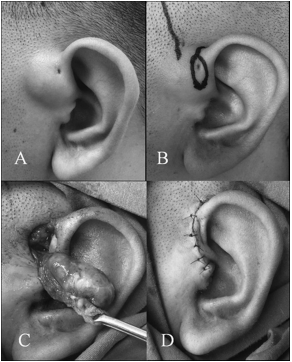Objectives. We aimed to summarize individualized surgical treatment approaches for congenital preauricular sinuses, based on a new surgical classification scheme.
Methods. Clinical data were retrospectively collected for 104 patients (117 ears) that visited our hospital and received surgical treatment from October 2011 to October 2017. All cases were classified into four types (I, II, III, and IV) according to the location of the preauricular sinus lesion and the presence of infection. Type I sinuses were defined as sinuses with mild or no inflammation. Type II and III were defined as sinuses with inflamed tissue close to (< 1.5 cm) or distant from (≥ 1.5 cm) the sinus openings. Type IV sinuses were referred to as “variant sinuses”, which were positioned in unusual areas.
Results. Type I sinus received a local, wide resection. Type II sinus underwent an extended local resection with an extended incision. Type III sinus received an extended local resection with double incisions. Type IV sinus received a local, wide resection, with or without a retroauricular incision. All pathological tissues were removed after one procedure. Within 7 days after surgery, 3.8% (4/104) of patients developed vomiting, and 2.9% (3/104) had a fever, but all issues were resolved with conservative treatment. During the follow-up period, only one recurrence (1/117, 0.85%) was observed in type IV preauricular sinus.
Conclusion. The preoperative classification of preauricular sinus can assist surgeons in selecting appropriate individualized surgical procedures with low recurrence rate.


_page-0001.jpg)
.png)

